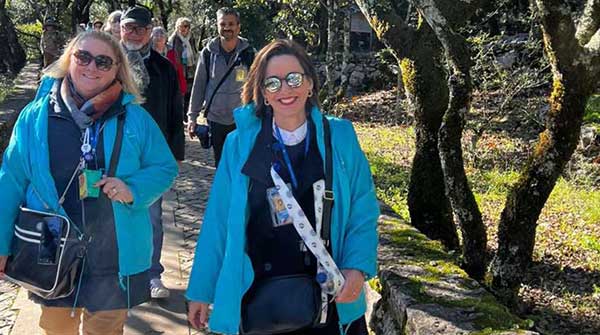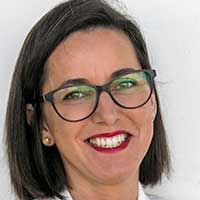Andreia Lopo guides international pilgrimages to sacred destinations such as Fatima and Lourdes, steeped in rich history

A pilgrimage is a source of spiritual enrichment, and the dream of a lifetime for many Catholics.
And Andreia Lopo, 47, takes “pure delight,” as she says, in helping to make that dream come true.
Lopo is a Portuguese tour guide and leads pilgrimages as well as secular tour groups. But accompanying a group of international pilgrims on an extended visit to such beloved sites as Lourdes and Fatima is something she does once a year, and one of her favourite professional activities.
As she recently escorted a group of 50 Canadians on an Aid to the Church in Need-sponsored pilgrimage through France, Spain and Portugal, her intense love and passion for her calling was palpable. So was her intimate knowledge of the history of some of the world’s most visited sites such as Lourdes, France, San Sebastian and Santiago de Compostella, Spain, and Fatima, Portugal.
 Andreia Lopo, right, with a colleague takes a group of pilgrims through Aljustre, home village of the three peasant children who witnessed the Marian apparitions at Fatima. As a tour guide, Lopo leads pilgrimages to many holy places, including Lourdes, France. |
| Related Stories |
| Pilgrimage cities of interest to all travellers, not just the religious
|
| Walking the Camino de Santiago in northern Spain
|
| Pilgrimage great way to give travel more meaning
|
Her childhood experiences in her native village in Portugal and her personal connection with at least one eyewitness to the miracle of the sun in Fatima place her in a unique position to bring the story alive to mesmerized audiences.

Andreia Lopo
Journalist Avelino de Almeido wrote in the Portuguese newspaper O Seculo in 1917 that an estimated 30,000 to 40,000 people witnessed the miracle of the sun that had been promised by Our Lady to three shepherd children, Francisco and Jacinta Marto, and Lucia Santos.
The mother of one of Lopo’s mother’s friends was one of these eyewitnesses.
“I grew up in the small, isolated village of Roliça, northwest of Lisbon,” Lopo said. “The drive to Lisbon was three hours long through twisting, hilly roads – there was no highway in those days – so we were pretty isolated.”
But life was idyllic in many ways.
Blessed with the love of family and neighbours, Lopo grew up sheltered by the genuine warmth and kindness of an entire village. This nurtured her sunny disposition and her own love of people of all ages.
“I wanted to share and spread this love that I received as a child, and also my passion for my own country’s remarkable history, with others,” she said.
While visiting Valinhos on the outskirts of Fatima with her fellow parishioners, she was awestruck by the serene beauty of the place and filled with admiration for the tour guides who were showing the Hungarian Calvary to visitors. The Hungarian Calvary is a pilgrimage site that features a Stations of the Cross route tracing the path of the three shepherd children as they led their flocks to drink from a pond. In addition, there is a chapel built by Hungarian refugees after the 1956 Soviet invasion of their country.
The sight of tour guides with their official badges, leading pilgrims through the Calvary, sealed Lopo’s decision to become a guide herself.
Her childhood memories have also led her to believe in the authenticity of the miracle of Fatima, she said.
“Everyone in the community knew each other, and though they were naïve in many ways, they had huge hearts filled with love for all the children of the village.”
Lopo’s mother owned a small grocery store where neighbours came every day to buy food and other essentials and, at the end of each month, to pay their bills. One of these neighbours was Suzete who, like everyone else, was a friend of her mother.
Lopo listened, fascinated, to Suzete’s story of her own mother and how she had witnessed the miracle of the sun on Oct. 13, 1917.
“The sun started to dance around itself and the air was filled with the fragrance of roses,” Suzete said of her mother’s experience.
Years later, Lopo was leading a tour of Fatima. She told the guide at the museum of miracles (an interactive museum where multimedia technologies simulate the miracle of Fatima experience for visitors) about Suzette’s mother’s real-life experience. The museum guide told Lopo that her grandmother had witnessed the miracle too, and that her experience was exactly the same as Suzete’s mother’s.
“In the year 2000, when Pope, now St. John Paul II, came to Fatima, he interviewed people who had witnessed the miracle when they were children,” Lopo said. “What was amazing was that their experiences were also identical to those of other eyewitnesses.”
She noted that this was before the days of Facebook and other social media, so they had no way of communicating and feeding off one another’s stories.
May 13, 2017, was a historic day at the shrine of Fatima. That was when Pope Francis canonized the two children, Francisco and Jacinta, formally elevating them to the rank of saints.
Lopo was working that day and wasn’t in Fatima, so she could not attend the ceremony. She made it a point, however, to follow the media coverage that evening.
“What stands out in my mind was the interview with the parents of Lucas and his sister at the steps of the altar,” she said.
She was referring to Lucas Batista Maeda de Mourao, a 10-year-old Brazilian boy whose miraculous cure paved the way for the canonization of Francisco and Jacinta. Four years before the canonization, he fell from the window of his grandfather’s home and suffered severe injuries to his head. As they rushed him to the hospital in an ambulance, his panic-stricken parents invoked the intercession of Our Lady, Francisco and Jacinta. That same night they and a local community of Carmelite nuns prayed to Francisco and Jacinta to intercede with God to cure the boy.
Some days later, to the doctors’ astonishment, the boy got up and walked home, completely recovered.
In February 2017, the Vatican’s Congregation for the Causes of Saints declared unanimously that his cure could not be scientifically explained. Pope Francis recognized his cure as the miracle that opened the door to the canonization of Francisco and Jacinta.
“Lucas was present at the canonization ceremony and brought up the offertory gifts,” said Lopo.
“Lucia, who became a Carmelite nun, died in 2005,” she added. “There are elderly nuns at her monastery in Coimbra who still remember her.”
Susan Korah is an Ottawa-based journalist. This article was submitted by The Catholic Register.
For interview requests, click here.
The opinions expressed by our columnists and contributors are theirs alone and do not inherently or expressly reflect the views of our publication.
© Troy Media
Troy Media is an editorial content provider to media outlets and its own hosted community news outlets across Canada.

